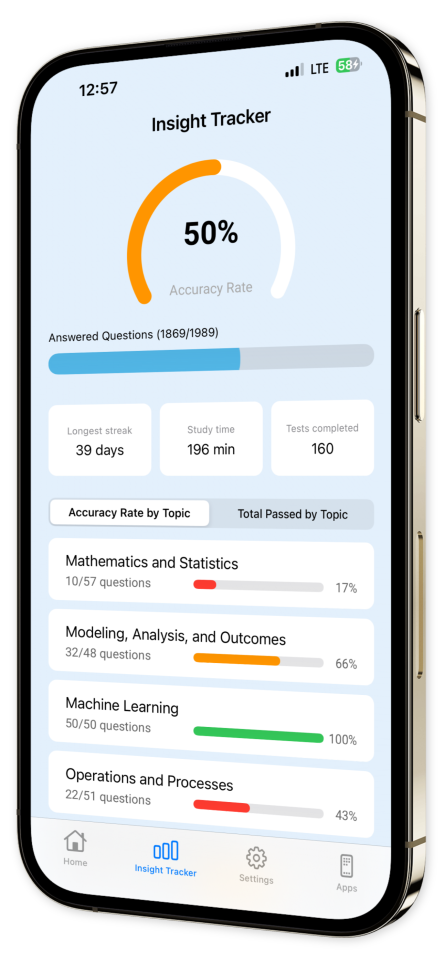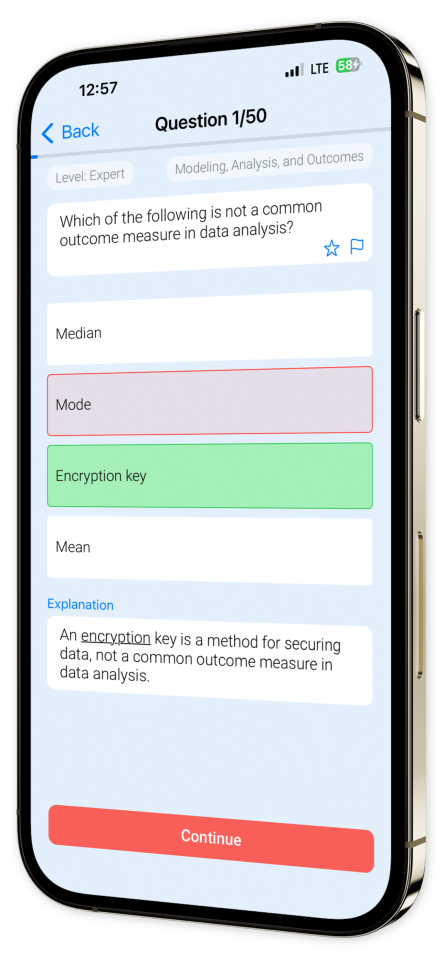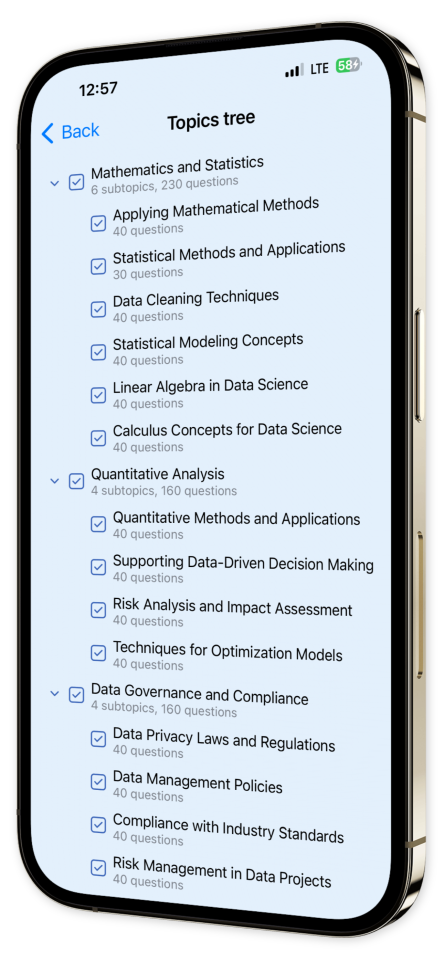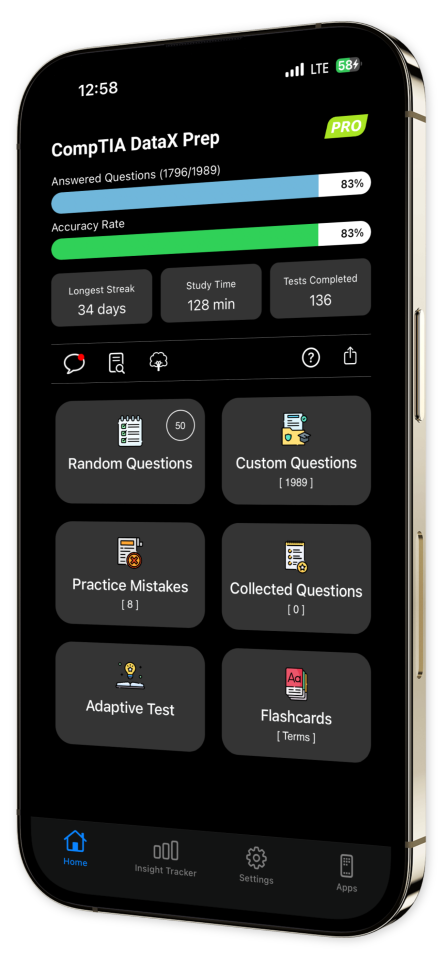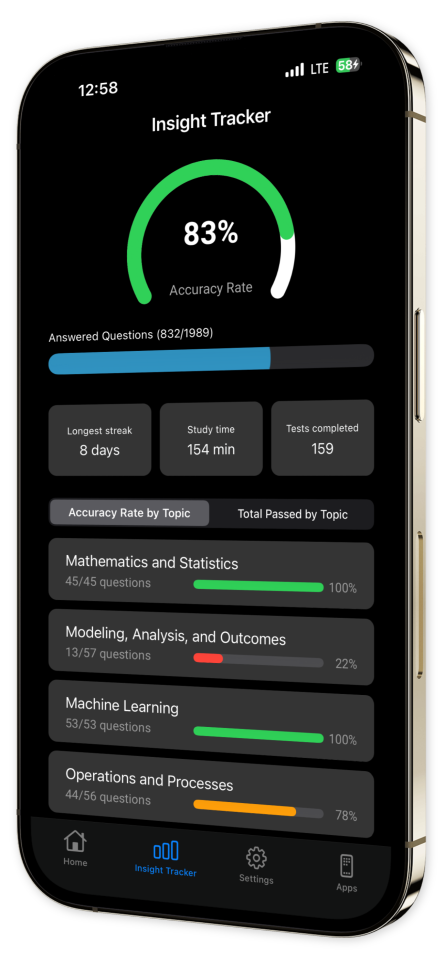
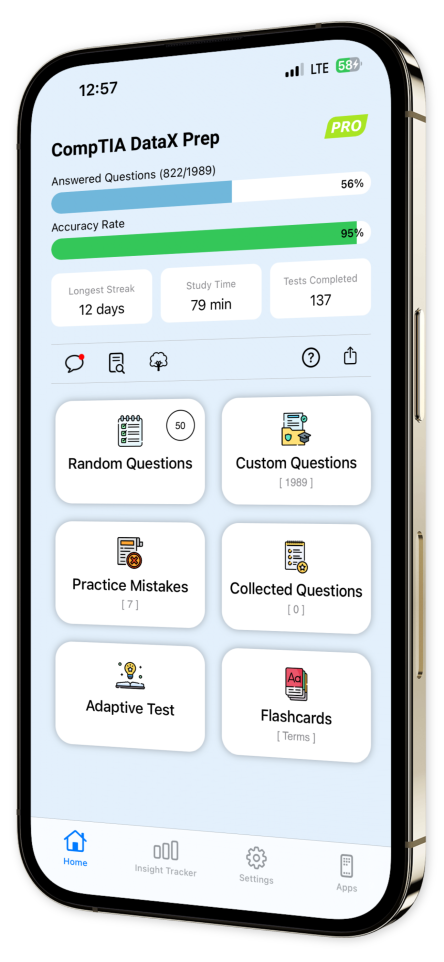
CompTIA DataX Prep iOS
Unlock the Power of Data Science and Machine Learning!
Introducing CompTIA DataX Prep — the ultimate app for preparing for the advanced-level CompTIA DataX (DY0-001) certification. Designed for experienced data professionals, this app equips you with the tools to master the intricate world of data science, quantitative analysis, and machine learning.
Advanced Data Science Challenges:
Tackle expert-level questions that dive into mathematical modeling, statistical methods, and machine learning algorithms. Each question is crafted to not only test your knowledge but also push the boundaries of your ability to derive insights from complex datasets and apply advanced analytical techniques.
Custom Machine Learning and Data Assessments:
Focus your learning with customizable tests that cover specific domains such as data science operations, model evaluation, and predictive analytics. Whether you need to refine your ML algorithm implementation or optimize data workflows, you can tailor assessments to match your areas of expertise.
Precision Performance Analytics:
Get in-depth analytics on your performance across core competencies, from data science processes to machine learning model deployment. With real-time insights, track your progress and identify areas for refinement, ensuring you’re fully prepared to tackle real-world challenges and ace the exam.
Thousands of professionals in data science and machine learning are enhancing their expertise with CompTIA DataX Prep. Download the app today and elevate your skills to master the evolving landscape of data science and machine learning!
Content Overview
Explore a variety of topics covered in the app.
Example questions
Let's look at some sample questions
What is the integral of the function f(x) = 1/x?
ln|x| + Cx^2/2 + C1/x + CNone of the above
The integral of the function 1/x is the natural logarithm of the absolute value of x, plus the constant of integration C.
Why is the concept of regularization used when justifying model choices?
To make the model more complexTo reduce overfittingTo add color to the modelTo make the model more attractive
Regularization is used in machine learning models to prevent overfitting. It does this by adding a penalty term to the loss function, which discourages overly complex models.
What is the main disadvantage of using a high learning rate in gradient descent?
It can cause the model to converge too slowlyIt can cause the model to converge too quicklyIt can cause the model to miss the global minimumIt can cause the model to overfit the training data
A high learning rate can cause the model to take large steps in the gradient descent algorithm, potentially causing it to miss the global minimum and fail to converge to the optimal solution.
Which of the following is not a type of machine learning?
Supervised LearningUnsupervised LearningReinforcement LearningUncontrolled Learning
Uncontrolled Learning is not a type of machine learning. The types of machine learning are Supervised, Unsupervised, and Reinforcement Learning.
Why is it important for a company to have a data breach response plan?
To ensure that the company can quickly react to a data breachTo comply with data protection regulationsTo minimize the impact of a data breachAll of the above
A data breach response plan is crucial for ensuring that a company can quickly react to a data breach, comply with data protection regulations, and minimize the impact of a breach. Having a plan in place can help mitigate damage, protect sensitive information, and maintain customer trust in the event of a breach.
What is the main difference between descriptive and inferential statistics?
Descriptive statistics summarize data, while inferential statistics draw conclusions from dataDescriptive statistics draw conclusions from data, while inferential statistics summarize dataDescriptive statistics are used for qualitative data, while inferential statistics are used for quantitative dataDescriptive statistics are used for quantitative data, while inferential statistics are used for qualitative data
The main difference between descriptive and inferential statistics is that descriptive statistics summarize data, while inferential statistics draw conclusions from data. Descriptive statistics provide simple summaries about the sample and the measures, while inferential statistics use patterns in the sample data to draw inferences about the population represented.
What is the difference between descriptive and inferential statistics?
Descriptive statistics summarize data, inferential statistics interpret dataDescriptive statistics interpret data, inferential statistics summarize dataThere is no differenceDescriptive statistics are used in data science, inferential statistics are not
Descriptive statistics provide simple summaries about the sample and the measures. Together with simple graphics analysis, they form the basis of virtually every quantitative analysis of data. Inferential statistics uses patterns in the sample data to draw inferences about the population represented.
What does 'dual problem' refer to in linear programming?
A problem with two solutionsA problem with two objective functionsA problem associated with another linear programming problemNone of the above
'Dual problem' in linear programming refers to a problem associated with another linear programming problem, where the objective function of one can be viewed as the constraint of the other, and vice versa.
How does a '51% attack' threaten a blockchain network?
By controlling 51% of the network's hashing powerBy attacking 51% of the network's nodesBy corrupting 51% of the network's dataBy stealing 51% of the network's digital currency
A '51% attack' threatens a blockchain network by controlling 51% of the network's hashing power, which can allow an attacker to manipulate the blockchain's transaction history and double-spend coins.
What is the main feature of Neuromorphic Computing?
Parallel ProcessingMimicking the human brainCloud StorageData Encryption
Neuromorphic Computing is primarily about designing systems that mimic the human brain's mechanisms.


